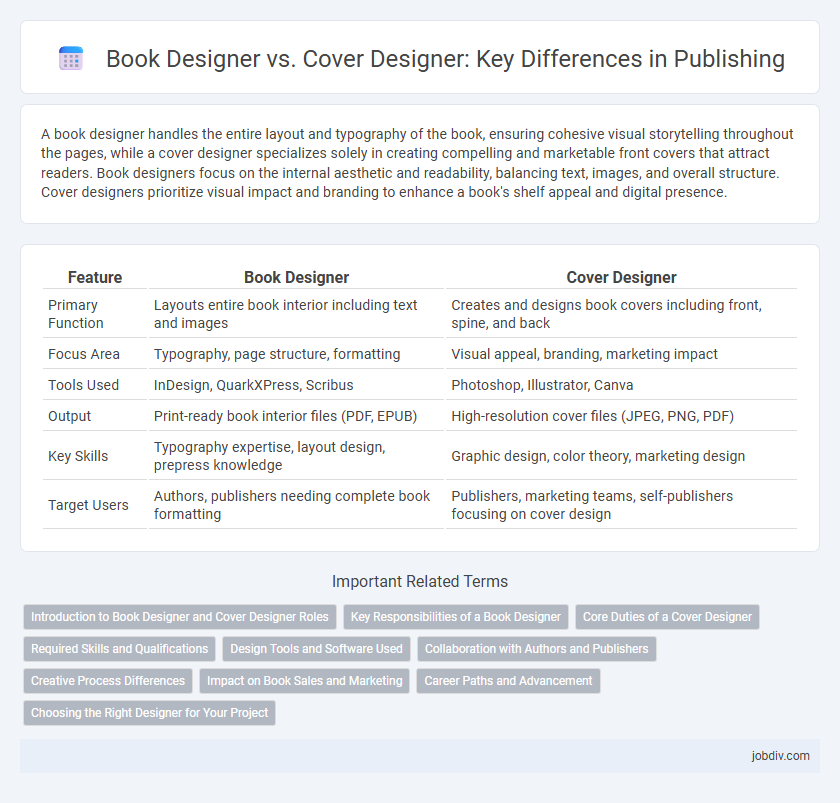A book designer handles the entire layout and typography of the book, ensuring cohesive visual storytelling throughout the pages, while a cover designer specializes solely in creating compelling and marketable front covers that attract readers. Book designers focus on the internal aesthetic and readability, balancing text, images, and overall structure. Cover designers prioritize visual impact and branding to enhance a book's shelf appeal and digital presence.
Table of Comparison
| Feature | Book Designer | Cover Designer |
|---|---|---|
| Primary Function | Layouts entire book interior including text and images | Creates and designs book covers including front, spine, and back |
| Focus Area | Typography, page structure, formatting | Visual appeal, branding, marketing impact |
| Tools Used | InDesign, QuarkXPress, Scribus | Photoshop, Illustrator, Canva |
| Output | Print-ready book interior files (PDF, EPUB) | High-resolution cover files (JPEG, PNG, PDF) |
| Key Skills | Typography expertise, layout design, prepress knowledge | Graphic design, color theory, marketing design |
| Target Users | Authors, publishers needing complete book formatting | Publishers, marketing teams, self-publishers focusing on cover design |
Introduction to Book Designer and Cover Designer Roles
Book designers focus on the entire layout and visual structure of a book, including typography, page formatting, and interior aesthetics to enhance readability and user experience. Cover designers specialize in creating compelling and marketable book covers, concentrating on visual elements like imagery, color schemes, and typography that attract potential readers. Both roles are essential in publishing, with book designers ensuring cohesive content presentation and cover designers driving initial consumer interest.
Key Responsibilities of a Book Designer
A Book Designer is responsible for the overall layout and visual structure of the entire book, including typography, page formatting, and interior design to ensure readability and aesthetic appeal. They work closely with authors and publishers to create a cohesive design that aligns with the book's theme and genre while managing elements like chapter headings, margins, and spacing. Unlike a Cover Designer who specializes solely in the book's exterior, the Book Designer's role encompasses both print and digital formats, ensuring a seamless reader experience across all platforms.
Core Duties of a Cover Designer
A Cover Designer specializes in creating visually compelling book covers that capture the essence of the story and attract target readers. Core duties include selecting appropriate typography, imagery, and color schemes that reflect the book's genre and tone. They collaborate closely with authors and publishers to ensure the cover design enhances marketability and stands out in competitive retail environments.
Required Skills and Qualifications
Book designers require proficiency in layout software such as Adobe InDesign and an understanding of typography, print production, and editorial design principles to ensure cohesive interior formatting. Cover designers emphasize skills in graphic design, creativity, and marketing insight, often using Adobe Photoshop and Illustrator to craft visually compelling covers that attract target readers. Both roles demand strong communication abilities and a keen eye for detail, but book designers focus more on structural design while cover designers specialize in visual impact and branding.
Design Tools and Software Used
Book designers primarily use software like Adobe InDesign and QuarkXPress to format interior layouts, ensuring text flow, typography, and overall readability meet publishing standards. Cover designers rely heavily on tools such as Adobe Photoshop, Illustrator, and Affinity Designer to create visually compelling cover art that attracts target audiences. Both roles require proficiency in design software, but book designers focus on page structure while cover designers emphasize visual branding and market appeal.
Collaboration with Authors and Publishers
Book designers collaborate closely with authors and publishers to develop the overall layout, typography, and interior aesthetics that enhance reader engagement and readability across various formats. Cover designers focus specifically on creating compelling visual elements and artwork that attract target audiences and convey the book's genre and tone effectively on shelves and digital platforms. Both roles require seamless communication and iterative feedback cycles to ensure the final product aligns with marketing strategies and author vision.
Creative Process Differences
Book designers focus on the overall layout, typography, and interior formatting to enhance readability and narrative flow, while cover designers specialize in creating visually compelling front covers that capture genre and target audience attention. The creative process for book designers involves balancing text arrangement, margin spacing, and chapter heading styles to support the reading experience, whereas cover designers prioritize color theory, image selection, and font choices to evoke emotion and market appeal. Both roles require collaboration with authors and publishers, but book designers work primarily with text structure, and cover designers concentrate on visual impact.
Impact on Book Sales and Marketing
Book designers influence book sales and marketing by ensuring optimal readability, layout, and typography, which enhances the reader's overall experience and satisfaction. Cover designers drive sales directly through visual appeal, creating striking covers that attract potential buyers and convey the book's genre and tone at a glance. Both roles synergize to boost marketability, but cover design often has the immediate impact on consumer purchasing decisions.
Career Paths and Advancement
A Book Designer oversees the entire layout and typography of a book, ensuring readability and visual appeal, while a Cover Designer specializes in creating compelling, market-driven cover art that captures the essence of the story. Career advancement for Book Designers often leads to roles such as Art Director or Publishing Manager, emphasizing comprehensive project oversight and collaboration with editors and authors. Cover Designers typically progress toward Senior Graphic Designer or Creative Director positions, where strategic branding and marketing expertise become crucial.
Choosing the Right Designer for Your Project
Selecting the right designer for your publishing project hinges on understanding the distinction between a book designer and a cover designer. A book designer specializes in the entire layout, typesetting, and interior elements, ensuring readability and aesthetic coherence throughout the manuscript. In contrast, a cover designer focuses solely on creating compelling visual artwork for the book's exterior to attract target readers and reflect the genre effectively.
Book Designer vs Cover Designer Infographic

 jobdiv.com
jobdiv.com